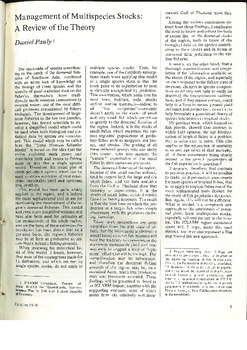Management of multispecies stocks: a review of the theory

Citation
Pauly, D. (1978). Management of multispecies stocks: a review of the theory. ICLARM Newsletter 1 (2): 3
The multitude of species contributing to the catch of the demersal fisheries of Southeast Asia, combined with an acute lack of knowledge on the biology of these species and the scarcity of good statistical data on the fisheries themselves, have traditionally made resource assessments in tropical waters one of the most difficult problems encountered by fishery biologists. The development of large-scale fisheries in the last two decades, however, has forced scientists to develop a simplified model which could be used when both biological and statistical data by species are nonexistent. This model which may be called here the "Total Biomass Schaefer Model" is based on the idea that the entire exploited stock grows and maintains itself and reacts to fishing more or less like a single species would. Therefore, the usual plot of catch-per-effect against effort can be used to obtain estimates of total maximum sustainable yield and optimum level of effort. This model has been quite widely applied in the region, and is indeed the most sophisticated tool in use for monitoring the development of the region's demersal fisheries. This model and even more simplified versions of it have also been used for estimates of the productivity of the whole region, and on the basis of these estimates the conclusion has been drawn that on a per-area basis, the region's fisheries may be at least as productive as certain North Atlantic fishing grounds. The theoretical basisi of this model was reviewed in this article.
Permalink